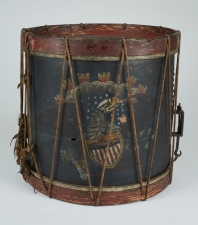As a musician, one of my favorite objects in our collection is this military snare drum that belonged to Jordan Bankston Noble (1800–1890), a formerly enslaved veteran of the Battle of New Orleans who volunteered in the 7th US Infantry Regiment. On January 8, 1815, Jordan was fourteen years old. He became a hero on the Chalmette battlefield that day by signaling drum calls as orders were issued by Major General Andrew Jackson. Jackson only spoke English, and several of the soldiers beneath him spoke French or Choctaw. For this reason, Jordan’s signals were of chief importance. In place of Jordan’s drum, shoddy translations may have led to a different outcome.
Jordan Noble didn’t play this drum in the Battle of New Orleans, and we know that because the manufacturer, Klemm & Brother, started importing instruments to the United States in 1816 and opened their Philadelphia storefront in 1819. According to our THNOC database, one New Orleans City Directory lists a Klemm & Brother retail store at 45 Canal Street in 1832. It is likely that Jordan purchased this military snare post-1832 and used it in later battles—perhaps in the Second Seminole War.
I have been building drums for over twenty years, and my favorite component of this instrument is the tuning mechanism—hand-sewn leather straps called “ear hooks” that group each pair of verticals. These are the predecessor of today’s drum keys, and Jordan would have had to pay close attention to their position. I can imagine him kneeling every so often, gently resting his drum on the ground to check the integrity of the hooks. In our year-round humid climate, Jordan would have needed to manipulate these hooks every few hours to check the tension on both drumheads. It would have been a matter of pride to stay in tune—akin to a soldier properly maintaining his weapon.
Jordan continued to play the drum for the remainder of his life, and newspaper records tell us that he was held in high esteem by the New Orleans community after the war. He was called to entertain audiences at the 1884 World’s Industrial and Cotton Centennial Exposition, when he would’ve been eighty-four years old. We have several objects and documents in our collection relating to Jordan Noble, and many of them are available to view in our online catalog. This snare drum stands proudly in our Louisiana History Galleries.

